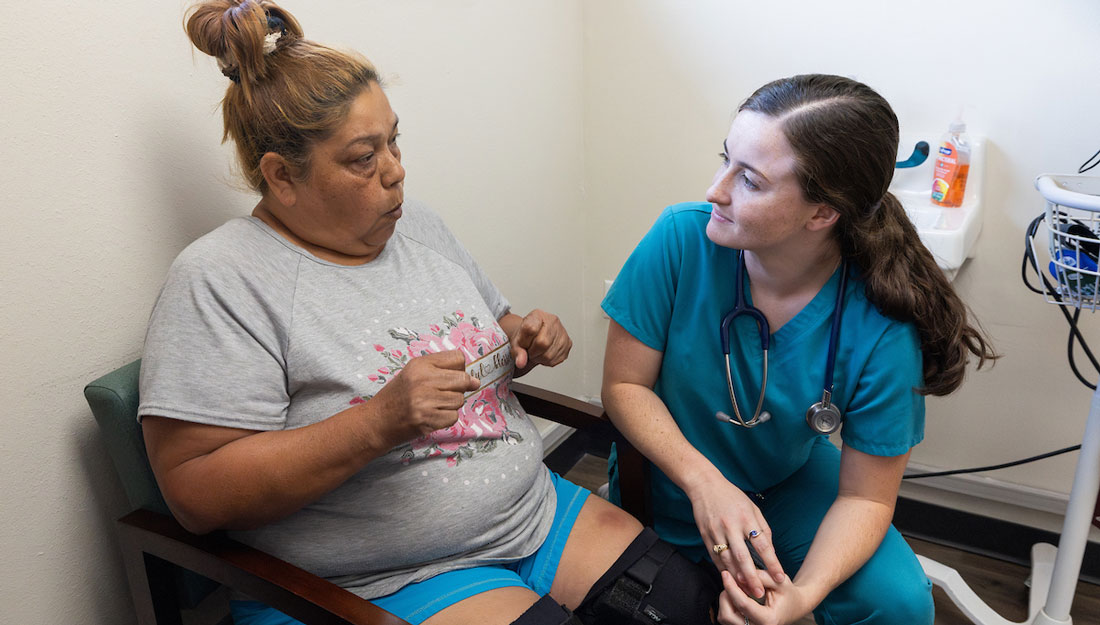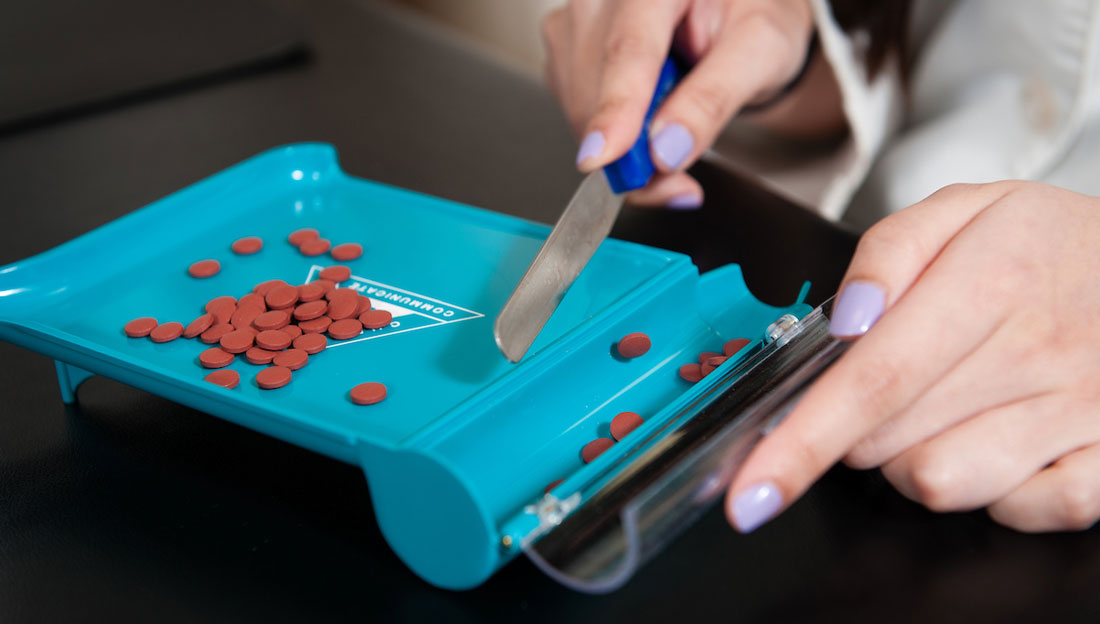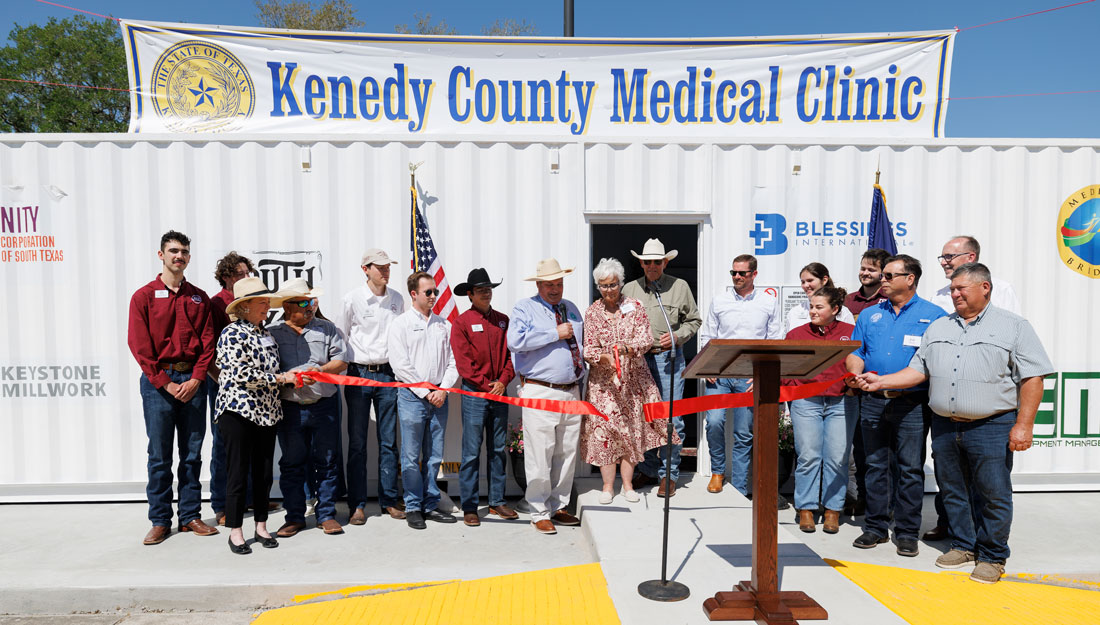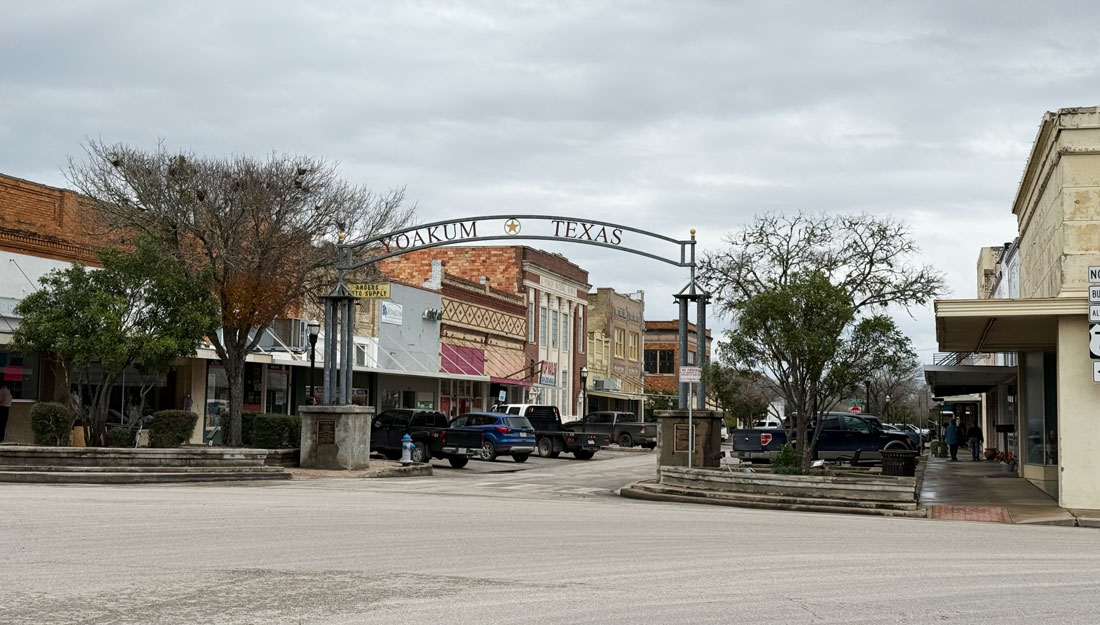- Lasha Markam and Lurel DeBrá
- Community, Community Impact, Medicine, Nursing, Show on VR homepage
Rural Engagement Program works to alleviate health care crisis in rural Texas
Joint partnership is providing rural clinics and hospitals with much needed financial, operational and workforce support

Chloe Todd, fourth-year medical student at the Texas A&M College of Medicine, has decided to pursue rural medicine because of the lasting relationships she will be able to build with patients. (Cameron Johnson/Texas A&M Health Marketing and Communications)
Emergency room (ER) physicians in big cities can diagnose concussions, set broken bones, confirm heart attacks and even care for spinal injuries in a single shift. That’s exactly what Texas A&M University medical student Chloe Todd ’25 wanted to do when she began her studies in 2021.
She looked forward to the variety of challenges that come with treating patients in a major metropolitan area. Her path was set. That is, until she signed up for a two-week rotation in rural Clifton, Texas, a town of 3,500 residents about 40 miles northwest of Waco.
During her rotation, a pregnant patient Todd saw in the clinic came into the hospital for a labor induction. Todd walked the patient through the process and administered her medication. She returned to the clinic for some appointments then was back in the hospital just in time to deliver her patient’s baby—all before lunch. Todd went back to the clinic, checked in at the ER then finished the day at the nursing home.
“I’ve never done that much in a single day,” Todd said. “It was crazy, especially in these different settings. Usually, you’re just in clinic or the hospital, but we kind of experienced everything in one day.”
Todd realized at that moment what Clifton had that a big city ER did not: the opportunity to treat patients in a variety of settings and to get to know them personally. Rarely do physicians see the same patient twice in most ERs, which makes developing a lasting relationship almost impossible.
“I think that was when I realized I wanted to do family medicine, because I wanted to be able to do all of that,” Todd said.
In addition to her experience in Clifton, Todd has completed several rotations in eight different rural counties throughout the state. She saw first-hand how unique each community is—some have full hospitals and others only have a small clinic.
“I love how these rural doctors not only take care of their patients but the community as a whole,” Todd said. “They see entire families and form strong relationships that last decades. I’d love to get to know my future patients in this way. It improves their patient care.”
The impact of immersive learning
The Texas A&M College of Medicine continues to build relationships with rural communities across the state to expose students to the unique and rewarding experience of caring for residents in a rural community. This commitment also sustains the communities’ health care workforce.
The college’s Rural Medicine Program launched in Mason, Texas, an agricultural community 95 miles northwest of Austin with a population of about 2,000 and the hometown of Curtis Donaldson, the program director.
“As we prepared to launch our pilot, I could not think of a better place than Mason,” Donaldson said. “Our community rallies around one another in time of need and around new opportunities that will help improve our community.”
When designing the Rural Medicine Program, Donaldson knew that fully integrating the students into the community was necessary to give them the best possible taste of small- town life. He recruited residents to host students in their homes, take them to high school pep rallies and football games and share what makes their town unique.
Getting to know the host families provided Todd with a deeper understanding of how important health care is in communities where residents may have to travel a significant distance to the nearest health care provider. She realized how critical it is for residents to have access to the care they need.
“If you lose health care in your community, the community slowly dies,” Todd said.
Partnership committed to supporting rural health care
The Rural Medicine Program is part of a larger rural health initiative at the Texas A&M University Health Science Center (Texas A&M Health)—the Rural Engagement Program. The program was funded by the Texas legislature in 2023 to accomplish three critical objectives: bolster rural health care, expand the workforce and strengthen the operational and financial viability of rural health facilities.
The Rural Engagement Program collaborates with the Texas A&M Rural and Community Health Institute (RCHI), which has worked with community health care organizations for more than 20 years.
Kia Parsi, MD, the executive director of both RCHI and the College of Medicine’s Rural Program, feels strongly that integrating these two programs will lead to increased improvements for rural health care in Texas.
“For years, various programs in Texas A&M Health have supported rural health care,” Parsi said. “Rather than continuing to operate in silos, the new Rural Engagement Program is designed to bring these efforts together for an even greater impact.”
Technical advisors meet face-to-face with health care administrators across the state to determine the specific needs of each facility then connect them with industry specialists to address the issues(s), at no cost to the clinic/hospital.
Coleman County Hospital, located an hour south of Abilene with a population of 7,600, often saw patients traveling 50 miles or more to receive specialized stroke treatment. Through funding from the Rural Engagement Program, Coleman County Hospital successfully completed the certification process necessary for “Stroke Ready Facility” designation. As a result, stroke victims in Coleman County and surrounding areas now receive life-saving care locally—a transformative step toward improving patient outcomes.
Nursing student now understands unique health care challenges of rural Texans
The College of Nursing is also committed to improving rural health care in Texas. One of the first nursing students to complete a rural-immersion clinical experience ended up with more than just nursing experience—she gained a new perspective on the unique health care challenges rural communities face.
“I now have a better perspective and greater respect for people who live in rural areas,” said Rachel Bode, a nursing resident in the Critical Care Nurse Residency Program at Cook’s Children’s Medical Center in Fort Worth. “Access to health care in rural communities looks very different than it does for people who live in the city.”
Even though Bode now practices in a major metro area, this perspective continues to influence how she treats her patients from rural communities. She recognizes what a burden it can be for patients who need to travel to bigger cities for care they’re not able to receive locally.
Navigating these relationships and providing care for these patients requires added understanding and sensitivity, Bode said. “It’s just different working with these patients compared to people who live here.”
Bode has considered returning to rural health care in the future because of what she gained from the experience.
“I’m always telling people that the experience was so meaningful,” Bode said. “It was a huge learning opportunity and I’m really grateful it’s now a program.”
To provide this opportunity to more health care students, the Rural Engagement Program is researching options for pilot rotations for the students in the College of Dentistry and the School of Public Health.
“We have approximately 4 million rural Texans that need health care,” Parsi said. “The Rural Engagement Program has created innovative ways to work with local communities, to increase workforce expansion and operational viability for these critical health care facilities.”
This collaboration between RCHI, the Rural Engagement Program, the College of Medicine and the College of Nursing is creating solutions for the health care disparities in rural communities from the Panhandle to the Rio Grande Valley. It’s another example of how Texas A&M Health is committed to its mission to serve all Texans and share its resources and ever-increasing knowledge with every community.
Media contact: media@tamu.edu


